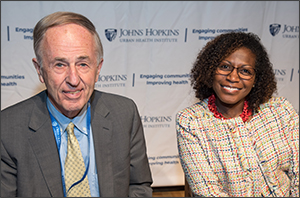How Communities and People Thrive!
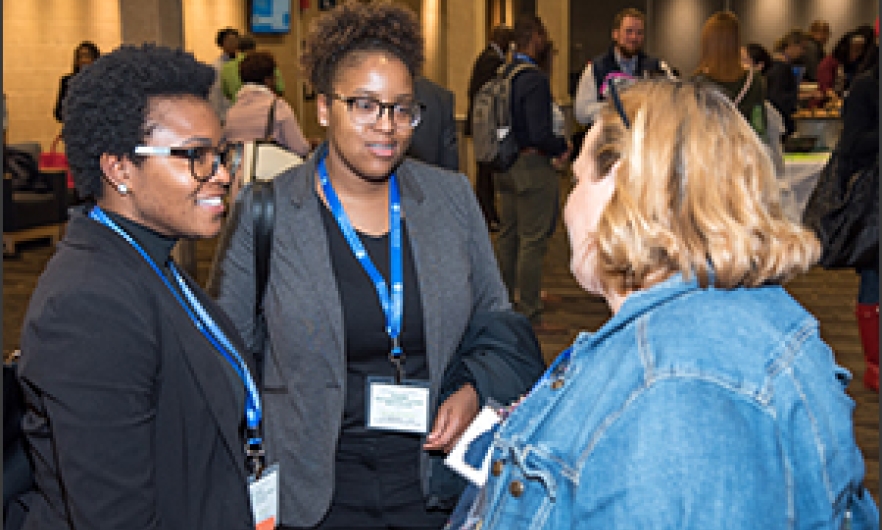
On May 13, 2019, the Johns Hopkins Urban Health Institute and Office of the Provost hosted its eighth annual Social Determinants of Health Symposium. This year’s theme was focused on how communities and people thrive. Discussions throughout the day took on a life-course approach by analyzing barriers to, and achievements in, health from infants and children to adults and seniors.
Addressing Structural Racism And Community Partnership
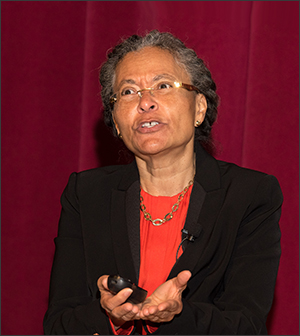
Keynote speaker Dr. Camara Phyllis Jones kicked off the Symposium discussing the importance of health equity, shared the barriers that cause health disparities, and provided solutions that can help eliminate those disparities and achieve health equity for all.
“We need to have solutions that are developed in communities, rather than just going to the community with ideas […] we need community originated research not just community-based research.”
Through her example of the metaphorical cliff, Dr. Jones went on to pinpoint racism and poverty as two major barriers to sustained improvements to health outcomes.
“We must be about moving the population away from the cliff by addressing poverty, adverse neighborhood conditions and the like [...] we must address racism, sexism, and capitalism if we want to achieve social justice and eliminate health disparities”
Dr. Jones explained the various levels of systematic racism and how it impacts those who benefit from it and those who don’t.
“Racism is a social determinant of equity and it is difficult to recognize a system of inequity that privileges us [...] racism is structural and creates multi-sided realities in our society.”
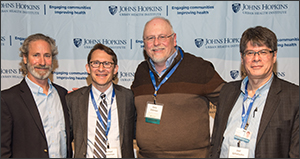
Housing commissioner Michael Braverman spoke during the healthy communities panel discussion and touched on the value of understanding racism, its history, and how it affects the housing structure in Baltimore.
“We need to start from a place of understanding slavery and institutionalized racism and how it plays out in Baltimore city, how it is woven into the fabric of present day, and how we make sure it doesn’t define the future.”
Led by James Piper Bond, the healthy communities panel also included Pastor Gary Dittman of Amazing Grace Church and Dr. Joel Gittelsohn of Johns Hopkins University.
In addition to structural racism, panelists shared similar sentiments about barriers that exist to communities thriving and things that can be done to help push the needle forward.
Some of which include improving food access in Baltimore City – “You can’t learn or be successful if you’re hungry”, shared Mr. Bond. In addition, Mr. Bond discussed how poverty, violence, inadequate education, and lack of workforce development and employment are major barriers to the success of communities. Mr. Bond, along with his co-panelists, expressed that listening, partnering, and empowering community is essential for communities to grow and thrive!
“The community is screaming we just aren’t listening to what they are saying […] they are the experts on determining what will make life better. Any programming that happens should come from the community”, explained Pastor Gary Dittman.
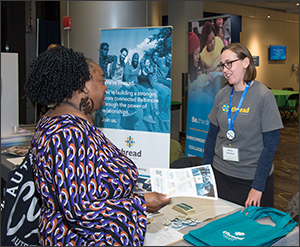
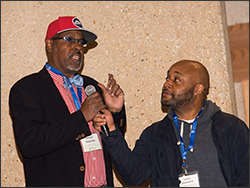
Removing Stressors And Barriers For Infants, Children, And Youth
Rebecca Dineen sparked off the discussion on the infants, children, and families panel. Sharing the impact racism and segregation have on current communities in Baltimore City, also known as the White L and Black Butterfly. Sharing the difference between the “White L” and “Black Butterfly”, Ms. Dineen acknowledged that in white communities there are low crimes, poverty, and some wealth while in Black communities also known as the “Black Butterfly” you see high poverty, high infant mortality, high crime, and low life expectancy.
“Where you are born in the city ultimately determines your life course and these acts didn’t develop by accident […] racial residential segregation is hard wired in Baltimore and deliberate political action created this”, said Ms. Dineen.
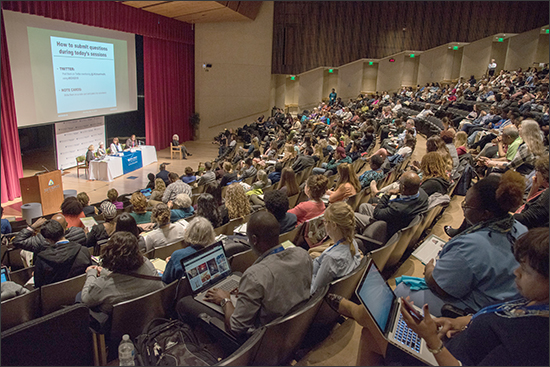
In a 2009 report by B’More for Healthy Babies, it was found that Baltimore was leading in high infant mortality with black babies fives times as likely to die compared to white babies. When posed the question why America’s black infants are dying, Ms. Dineen pointed to institutional and interpersonal racism and how it creates isolation for those on the receiving end through racial residential segregation and produces biological response to chronic stress over the life course.
Joined by Professor Anne Duggan, Debbie Rock, and Danitza Simpson-Escano, the conversation included messages about looking beyond the health of a child and analyzing the overall health of the family and environment in which the child is birthed in; and eliminating stressors that contribute to the health and well-being of infants, children, and youth, such as poverty.
Debbie Rock opened and closed with this message, “Our ultimate goal should be helping families to break multi-generational poverty […] that means just because grandma started off on welfare doesn’t mean her adult child or grandchild has to continue it. We can help that cycle be broken.”
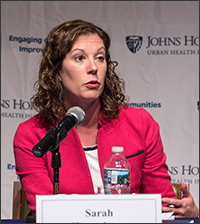
Sarah Hemminger, founder of Thread, spoke on the adolescent and youth panel and shared the same sentiments about identifying and eliminating outside stressors for youth.
“There is this deep understanding that there is nothing wrong with our young people. They are beautiful and capable and talented by they are often distracted by things happening outside of the classroom.”
Ms. Hemminger was joined by Joni Holifield, Tamar Mendelson, and Dana Stein. During the discussion, panelists shared their experiences working face to face with youth in the community and what they’ve learned works and did not work. Joni Holifield left attendees with a simple strategy, using the letters of the word STOP, to follow when working with youth.
S – Seek to build an authentic relationship
T – Time matters. Your presence is more important than the presents you give.
O – Overcome obstacles together. Don’t just remove barriers and not show them how they can remove barriers for themselves.
P – Position yourself to serve and support.
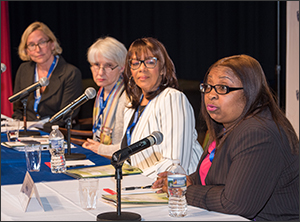
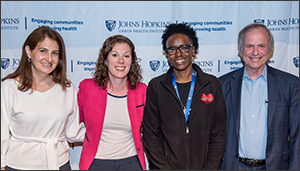
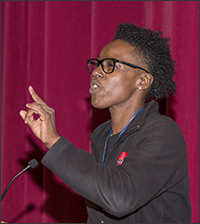
Supporting Adults And Engaging The Elderly
“Do you know how frustrating it must feel? To see the playing field, know that you can play on it, but you can’t get in the game”.
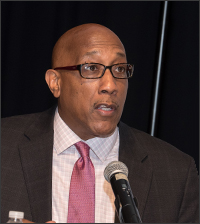
Joseph T. Jones Jr., founder of the Center for Urban Families, kicked off the Adult and Seniors panel with Dr. Michelle Carlson, Dr. Sarah Szanton, and Melvin Wilson, and expressed the importance of empowering adults and seniors economically through job security and opportunity and passing legislation that equip adults and seniors to thrive in their communities.
Panelists shared their experiences with connecting adults and seniors to opportunity, success stories, and the challenges they’ve observed along the way.
“When you overlay environmental risk factors with individual risk factors, we find that people with the greatest cognitive risk also live in the region with the greatest environmental risk […] we need to meet people where they are”, shared Dr. Carlson.
Melvin Wilson of TurnAround Tuesday expanded the conversation about meeting people where they are by sharing the work, they do in assisting formerly incarcerated community members, referred to as returning citizens, with their re-integration back into society and securing jobs.
“As a in society, we continue to punish people after they’ve already done their time […] we have a lot of challenges Baltimore, but all of us have to come together to do the work. All of us are just one incident away from our lives changing forever.”
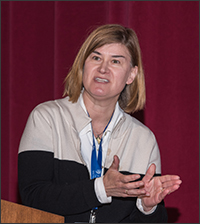
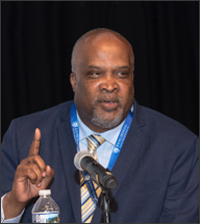
Put The Money Where The Community Is
The philanthropy panel closed out the day. Baltimore foundation leaders – Robert C. Embry, Lisa Hamilton, and Shanaysha Sauls – gathered to discuss the commitment of philanthropists in Baltimore city and shared how their involvement often goes beyond providing funding but also involves community engagement, meaningful dialogue, and gathering data to help inform institutions on what is happening in the community.
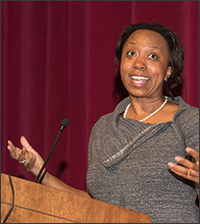
While each foundation shared their different focuses, which include bridging the wealth and equity gap that exists among African American communities to ensuring children realize their potential and have the brightest future, all three of the foundations emphasized the same belief that many of the speakers touched on throughout the day, partnership is essential and community should be at the center.
“Its important for us to align our strategies, continue to be in conversation with one another, and complement one another as members of the philanthropic institutions of Baltimore. We each bring different sets of knowledge to bare in the conversation […] we become a virtuous circle with the people being in the middle.”
To view photos from the May 13th Social Determinants of Health Symposium please visit our Facebook page.
